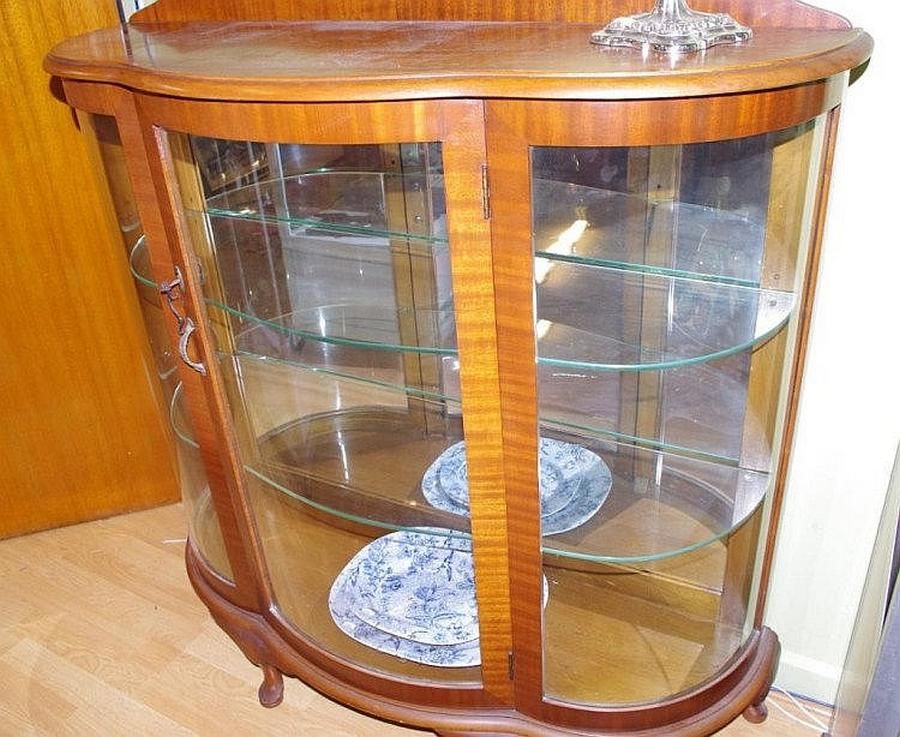Understanding Curved Glass China Cabinets

Curved glass china cabinets are a captivating addition to any home, adding a touch of elegance and sophistication to any room. These cabinets stand out with their unique design features, combining functionality and aesthetic appeal.
Design Features
Curved glass china cabinets are characterized by their graceful, flowing lines and the use of curved glass panels. The curved glass panels, often made of tempered or laminated glass, provide a panoramic view of the displayed items, enhancing their beauty. The curves add a sense of movement and visual interest, making these cabinets a focal point in any space.
Materials
Curved glass china cabinets are typically constructed using a combination of materials:
- Wood: The most common material for the frame and cabinet body. Popular choices include hardwoods like oak, cherry, maple, and walnut, known for their durability and aesthetic appeal.
- Glass: The curved glass panels are often made of tempered or laminated glass, providing strength and safety.
- Metal: Metal accents, such as hinges, knobs, and decorative elements, can add a touch of sophistication and complement the overall design.
Styles and Variations
Curved glass china cabinets come in a wide variety of styles and variations, reflecting different design aesthetics and periods:
- Traditional: These cabinets often feature intricate carvings, ornate moldings, and dark wood finishes, exuding a timeless elegance.
- Modern: Modern styles emphasize clean lines, minimalist designs, and sleek finishes, creating a contemporary look.
- Contemporary: Contemporary styles blend traditional elements with modern influences, offering a unique and stylish look.
- Art Deco: Art Deco-inspired cabinets feature geometric patterns, bold colors, and metallic accents, adding a touch of glamour and sophistication.
Repairing Curved Glass China Cabinets: Curved Glass China Cabinet Repair

Repairing a broken or cracked curved glass panel in a china cabinet can be a challenging task, but with the right approach, it can be done successfully. Curved glass is unique due to its shape, making it more susceptible to breakage than flat glass. This guide will walk you through different repair techniques and considerations for restoring your china cabinet to its former glory.
Repairing Curved Glass Panels, Curved glass china cabinet repair
The type of repair needed depends on the extent of the damage. Minor cracks can be stabilized with a resin-based adhesive, while more significant damage might require replacement.
Using Resin-Based Adhesives
For minor cracks, resin-based adhesives offer a cost-effective and relatively easy repair solution. These adhesives are designed to bond to glass and create a strong, durable seal.
- Cleaning the Surface: Begin by thoroughly cleaning the glass surface with a glass cleaner and microfiber cloth. Ensure the surface is free of any dirt, dust, or debris.
- Applying the Adhesive: Apply a thin, even layer of resin-based adhesive to the crack. Use a small applicator or a toothpick for precise application.
- Curing the Adhesive: Follow the manufacturer’s instructions for curing time. This typically involves allowing the adhesive to dry completely, which can take several hours or even overnight.
- Polishing the Surface: Once the adhesive has cured, gently polish the area with a fine-grit sandpaper to smooth out any rough edges.
Replacing the Curved Glass Panel
When the damage is extensive or the crack is too large to repair, replacing the curved glass panel is the best option. This requires professional expertise and specialized tools, as curved glass requires precise measurements and cutting.
- Measuring the Panel: A glazier will accurately measure the existing panel to ensure the replacement is a perfect fit.
- Cutting the Glass: Curved glass requires a specialized glass cutter and techniques to create the desired shape.
- Installing the Panel: The new panel is carefully installed in the china cabinet, ensuring a secure fit.
Choosing the Right Tools and Materials
Selecting the right tools and materials is crucial for a successful repair.
Tools for Repairing Curved Glass
- Glass Cutter: A specialized glass cutter designed for curved glass is essential for precise cutting.
- Resin-Based Adhesive: Choose a high-quality resin-based adhesive specifically designed for glass repair.
- Applicator: A small applicator or toothpick is helpful for applying the adhesive precisely.
- Sandpaper: Fine-grit sandpaper is used to smooth out any rough edges after the adhesive has cured.
- Protective Gear: Always wear safety glasses and gloves to protect yourself from glass shards and chemicals.
Materials for Replacing Curved Glass
- Curved Glass Panel: A new curved glass panel, precisely cut to the dimensions of the original.
- Glazing Putty: A glazing putty is used to secure the new panel in place.
- Glazing Tools: A set of glazing tools is necessary for applying and smoothing the glazing putty.
Curved glass china cabinet repair – Repairing a curved glass china cabinet can be a delicate process, requiring expertise in handling both glass and antique furniture. While a curved glass china cabinet is often a treasured heirloom, similar glass doors are also found in more modern pieces like console cabinets with glass doors.
These cabinets, with their open design, offer a beautiful display for decorative items. Whether it’s a vintage china cabinet or a modern console, understanding the nuances of glass door repair ensures these pieces remain functional and aesthetically pleasing for years to come.
Repairing a curved glass china cabinet requires a delicate touch, especially when dealing with antique pieces. The intricate curves and potential age-related fragility demand specialized techniques. If you’re considering restoring a vintage cabinet, you might find inspiration in the elegance of antique wall cabinet glass doors , which often feature similar curved glass designs.
Understanding the history and craftsmanship of these antique pieces can help you approach the repair of your curved glass china cabinet with respect and precision.
